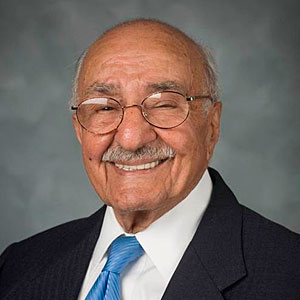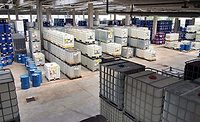Designer of Dangerous Goods Placard System Retires After 40-Year Career

Abe Samuels
The distinguished and nearly never-ending dangerous goods shipping career of 95-year-old Abe Samuels finally concluded when his employer of 40 years, Chicago-based Labelmaster, hosted a retirement celebration on May 26. Samuels’ crowning achievement, in addition to working every week and traveling on business while in his mid-90s, is one that will continue to be viewed by anyone who travels America’s highways.
Samuels is the developer of the Spacemaster flip placard system that allows trucks and tankers to easily display signage that indicates the presence of dangerous goods (DG) on board, so critical to alert first responders to any potential hazards if an accident occurs. The beauty of Abe’s design is its simplicity and flexibility to communicate the wide variety of hazardous materials often transported on just one carrier to ensure regulatory compliance and foster safety.
“It wasn’t until 1976 when Congress mandated that placards be displayed on trucks to identify the many different kinds of hazardous materials being transported,” Samuels said. “For decades, Labelmaster has been helping companies meet DG regulations with packaging and labeling, but now placarding was required before shippers were put into commerce.”
Yet, this presented a challenge when a carrier transported a mixed load of various DG commodities that needed to be identified. Today there are nine categories of hazards with 24 divisions among them.
Samuels, relying upon his prior background in tool and die work and designing plumbing products, developed the Spacemaster, a flip placard system that enables carriers to quickly select and display the appropriate placard for each DG load. All of the required legends are available in one system, created by flipping numbers, colors and the names of hazard classes.
These systems would go on to become the standard in the industry used by most of the top carriers.
“By design, these adaptable signs are customized for each kind of load, so the carrier can tell the shipper, ‘I have all of the signs required and can place your shipment into commerce immediately’,” Samuels said. The system is offered in different variations and number of placards, ranging from a basic two for flammable and non-flammable gas all the way up to 17 that can highlight materials that are labeled as explosive, poison, radioactive, corrosive, combustible and more.
“Such identifiers provide information for first responders at an incident who need to determine the appropriate firefighting techniques, the special equipment that may be required and necessary evacuation distances,” Samuels explained. “The signage must be displayed on the front and back, and each side, of the trailer.”
So, when stuck behind a truck on the interstate, one likely will see and admire Abe Samuels’ design that fosters safety, now affixed to thousands and thousands of trailers. It may even be a Samuels’ original, as Abe laments that the highly durable, corrosion-resistant aluminum frames and aluminum, alloy placards seemingly last forever, minimizing repeat sales.
Remarkable longevity – just like its creator.
Looking for a reprint of this article?
From high-res PDFs to custom plaques, order your copy today!







